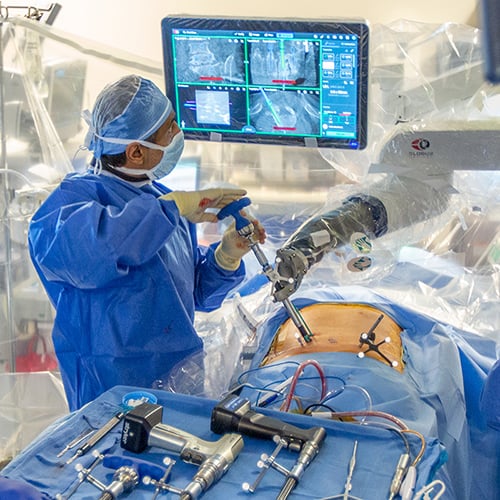Minimally Invasive Spine Surgery
Summary: Many areas of medicine have made significant advances in “minimally invasive surgery,” in which surgical treatment is accomplished using smaller cuts instead of large openings in the body, usually with special tools and/or cameras. For example, many joint surgeries in the knee or shoulder are now done with a small camera called an arthroscope. Spine surgery is moving in the same direction. But because the spine is so complex, not every condition can yet be treated with minimally invasive techniques.

This article provides an overview of minimally invasive spine surgery, cases where it can or cannot be used, and links to more information, such as articles on individual procedures.
Hospital for Special Surgery has led the way in developing new techniques for minimally invasive surgery (MIS), which involves the use of customized instruments, imaging technology and incisions. However, the size of the first incision on the skin's surface is not the most important part of the process. More important are the techniques and instruments that allow the surgeon to "tunnel" beneath the muscles and ligaments that surround the spine, while still safely and effectively treating a person's spine condition.
On this page:
What is minimally invasive spine surgery?
Minimally invasive spine surgery (MISS) refers to muscle-sparing approaches to the spine that use small incisions as access portals. They are often performed using live X-ray or CT scan imaging for guidance, as well as robotic surgery (also called robotic-assisted surgery). This speeds up recovery periods while achieving the best possible outcomes.
In MISS, the surgeon will approach the spine from one of three positions, depending on the patient's age, symptoms, spine alignment, and the anatomy of the nerves and blood vessels. These positions are:
- anterior – from the front
- lateral – from the outer side (flank)
- posterior – from the back
In most cases, access to the spine is established by using a series of dilators that split the muscle to create a working portal. The size of this portal will vary depending on the surgeon and the specific spine surgery being performed. Using these techniques, however, spine surgery access portals can now be as small as 1.2 centimeters (about a half an inch).
When the spine needs to have screws and rods inserted to hold it in position (called instrumentation), this can also be performed through small incisions with the assistance of intra-operative X-rays, CT scans or robotic guidance.
Benefits of minimally invasive spine surgery
The chief benefits of minimally invasive spine surgery are:
- smaller cuts and less blood loss
- shorter hospital stays
- faster recovery
- less disruption to muscles and soft tissue
Limitations of minimally invasive spine surgery
Patient safety is always the top priority. In some cases, doing surgery through a larger opening gives the surgeon a better view than in minimally invasive spine surgery. This may help avoid complications such as nerve injury, poor bone healing, or problems with hardware. For this reason, surgeons choose the approach that is safest for each patient, not simply the smallest incision possible.
As the U.S. population ages, more people will need spine care. This makes it more important than ever to continue developing surgical techniques that are safe, effective, and affordable. MISS is one way to help control costs, especially since it can sometimes be done in an outpatient surgery center rather than a hospital.
Many procedures, like microdiscectomy, laminectomy, and cervical spine fusion, are already being done safely on an outpatient basis as ambulatory surgery centers. For some patients, even small spinal fusions can be done this way. But people who are older or who have other health issues may still be better cared for as an inpatient in a hospital.
Who should not have minimally invasive spine surgery?
Complex spine problems, such as scoliosis or kyphosis) deformities that involve numerous levels of the spine, often still require more open procedures. Even for simpler procedures involving only few or even just one spinal level, some health conditions and lifestyle factors may preclude a person’s ability to undergo minimally invasive spine surgery. This is especially the case if a spinal fusion might normally be recommended. Common examples include people who have severe osteoporosis of the spine (making it unsuitable for instrumentation), heavy smokers, and people undergoing active cancer treatments.
The patient and surgeon must carefully review any health concerns that may lead to surgical complications.
Technology in the operating room
Improved technology continually makes spine surgery more precise. Image-guided navigation, robotics, and “smart” instruments are being tested and, in some cases, already used. These tools can help the surgeon place screws more accurately, protect nerves, and reduce trauma to muscles.
New technologies in minimally invasive spinal fusion
Advances in materials science and other technology have changed what surgeons can use during minimally invasive spinal fusion surgeries, including:
- Synthetic implants and biologics: Instead of taking bone grafts for fusion from a patient’s own body (which can cause pain at the site from which the donor bone is taken), surgeons can now use special materials to help bones heal.
- 3D-printed implants: These can be custom-made to fit a patient’s spine and are designed to help bone grow into them.
- Improved metals and plastics: New types of titanium and other materials reduce problems with imaging after surgery and help bones heal better.
Video: The Future of Spine Surgery Innovation
Robotic minimally invasive spine surgery
Robotic-assisted spine surgery is becoming more common as costs come down and systems improve.
Until very recently, the use of surgical robots in spine surgery had been limited to the insertion of instrumentation such as pedicle screws and interbody cages.
Today, robotic surgical systems can precisely map the posterior (rear) portions of bones in the spine, such as a lamina or facet joint. They can then also remove tiny portions of these structures that are pressing on nerves and causing a person’s pain and radiculopathy symptoms.

Key takeaways
- Definition: Minimally invasive spine surgery (MISS) uses small incisions, imaging, and specialized tools to treat spine conditions while minimizing muscle and tissue disruption.
- Benefits: Smaller cuts, less blood loss, shorter hospital stays, faster recovery, and less muscle damage.
- Limitations: Not every spinal condition can be treated with MISS. Larger openings are sometimes required to prevent complications.
- Patient selection: MISS may not be suitable for people with severe osteoporosis, complex deformities (like scoliosis), active cancer treatment, certain health risks, or who are undergoing active cancer treatment.
- New advances: Synthetic bone graft materials, 3D-printed implants, other improved materials and robotic-assisted surgical systems support better outcomes.
Learn more in the articles below.
References
- Altrofer FC, Avrumova F, Lebl DR. Robotically-assisted Decompression, Decortication, and Instrumentation for Minimally Invasive Transforaminal Lumbar Interbody Fusion [video]. Hospital for Special Surgery eAcademy; 2025 Jan 24. Available from: https://www.eacademy.hss.edu/courses/robotically-assisted-decompression-decortication-and-instrumentation-for-minimally-invasive-transforaminal-lumbar-interbody-fusion. Accessed 2025 Mar 3.
- Altorfer FCS, Kelly MJ, Avrumova F, Burkhard MD, Sneag DB, Chazen JL, Tan ET, Lebl DR. Minimally invasive robotic-assisted lumbar laminectomy. Bone Jt Open. 2024 Sep 27;5(9):809-817. doi: 10.1302/2633-1462.59.BJO-2024-0066.R1. PMID: 39326874; PMCID: PMC11427110.
- Lebl DR. Minimally Invasive Spine Surgery. Curr Rev Musculoskelet Med. 2017 Sep;10(3):407-408. doi: 10.1007/s12178-017-9429-0. PMID: 28780724; PMCID: PMC5577430. https://pmc.ncbi.nlm.nih.gov/articles/PMC5577430/
